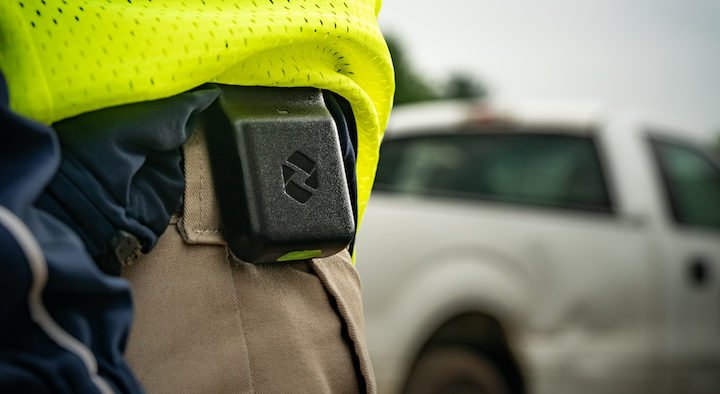
It’s commonly known that the construction industry is slow to adopt technologies, but new regulations, safety challenges and data-driven jobsites are driving builders to break that stereotype. According to Robert Costantini of Triax Technologies, contractors can enjoy many advantages from the use of data and analytics, including increased safety and reduced risk.
Costantini is the CEO for the Norwalk, Conn.-based company, which offers its Spot-r system to help clients find their resources on jobsites and determine how they are interacting. Recently, he spoke to Construction Best Practices about how builders can leverage data and analytics to operate more productively.
Construction Best Practices: The data-driven jobsite is becoming a necessity. How can contractors leverage data from IoT (Internet of Things) and wearable sensors to their advantage?
Robert Costantini: IoT and wearables sensor data can have tremendous impact on risk mitigation in terms of occupational risk and builders’ risk. Being able to gain information in real time from workers, equipment, materials and the environment will help to proactively address areas of risk quickly to prevent or mitigate potential damage.
For example, gaining visibility on jobsites into the whereabouts of workers and equipment with real-time data provides the ability to make decisions that may avoid unsafe conditions, such as knowing equipment operators and whether they’re certified for that piece of machinery, and monitoring workers in confined spaces or hazardous areas like trenches.
In addition, real-time data collection capability provides lone workers with a way to use the wearable sensors to communicate injuries and incidents in a way that dramatically reduces response time to help them. Being able to understand the location and movement of materials or site issues like standing water, by using IoT sensors, could potentially reduce builders’ risk. These are all ways that data is being used to mitigate risk and improve safety.
CBP: How can they use analytics to operate smarter, safer and more productively?
RC: In the short term, collecting data provides the ability to measure key performance indicators (KPIs) to better understand that projects are meeting budget and schedule, or if workers are prone to unsafe behavior such as low-height jumps that could be corrected with training. It also provides the ability to measure other KPIs, such as productivity levels of crews from insights into where workers are spending their time on-site.
Analytics will also allow benchmarking of worker risk, such as worker experience levels with the trade, or employer, or job site tenure. Over the long term, analytics will create smarter, safer and more productive jobsites by comparing data over many projects. For example, some of our clients are wrapping up their first few projects with us and aim to use that data to help with future project planning, specifically:
- Better pricing risk.
- Planning subcontractor scheduling and budgeting.
CBP: How will safety become more regulated than it already is now?
RC: I think we will see more municipalities follow suit from what New York is doing with Local Law 196. Our clients are able to use Spot-r technology to help them with compliance by collecting data as to who is on-site and the status of their compliance with laws regarding safety training and certifications. Notifications can be set when workers with expired certifications or soon-to-be expired certifications arrive on site so they can stay on top of it. They are also able to instantly provide reports during a surprise inspection showing that their sites are compliant with safety training regulations.
CBP: Why should contractors turn more to integrated systems instead of one-off solutions?
RC: Integrated solutions help with technology adoption in construction by putting all of the contractor’s varied technologies in one place. There has been such an influx of technologies in the marketplace it can overwhelm contractors who don’t want to have to manage several different systems to get their information. At Triax, we consider our focus on occupational safety and productivity to be such an essential technology for the connected jobsite that we support both software and hardware integrations with our open API so information can flow between systems seamlessly.
CBP: Are builders using your technologies to monitor jobsite safety in relation to COVID-19?
RC: Yes. Just recently (April 15) we launched an IoT solution – Proximity Trace, which provides social distancing alerts and contact tracing through a wearable device for workers across many industries, including construction, heavy industrial, energy and manufacturing. It offers added protection for essential workers during the COVID-19 pandemic and helps companies get workers back to work safely, while addressing recommended social distancing practices. Gilbane Building Company is rolling out the solution at its active sites and it’s confident in the role it can play in keeping workers safer at those sites as well as non-essential sites as it begins returning those to full operational status in the months to come.
CBP: What do you see for the future of Triax and its industry?
RC: Our vision for the future of Triax is to be the global leader in jobsite data collection using industrial wearables and other sensors, delivering significant ROI for customers through actionable real-time data, predictive analytics and AI/machine learning, making industries like construction data driven. Construction projects are getting larger, schedules are getting compressed, and worker shortages are ramping up risk and impacting profitability, making the industry ripe for increasing its use of data insights to improve safety and productivity.

